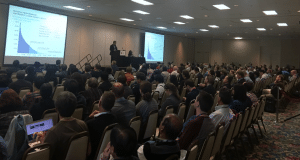If you didn’t get to the Plant and Animal Genome meeting this year, you missed a great workshop featuring SMRT Sequencing users and the fascinating projects they’re working on across plant, animal, agricultural, and conservation sciences and human health. Here are quick summaries of each talk, with full video recordings available for more detail.

Our event kicked off with PacBio CSO Jonas Korlach welcoming attendees and delivering an update on the genomics community’s impressive advances with SMRT Sequencing. There are now more than 2,000 publications citing the PacBio long-read technology — a rate of about 30 per week. He also spoke about improvements to the platform, including better assembly tools such as FALCON and FALCON-unzip as well as the recently released Sequel System chemistry that delivers 5-8 Gb of data per SMRT Cell and significantly reduces DNA input requirements. These improvements make it possible to run a broader range of projects on the Sequel System.
Representing the plant side of the conference, the University of Arizona’s Rod Wing spoke about using SMRT Sequencing to produce high-quality genome assemblies for several varieties of rice. He’s undertaken this project to help develop higher-yielding, hardier strains of rice to feed the rapidly growing global population. In the work he presented, his team sequenced two parents of a common hybrid strain, generating the highest-quality publicly available assemblies of Indica rice ever produced. His data illustrated how long-read PacBio sequencing allows for excellent contiguity in assemblies, with one strain represented in just 19 contigs and a strain featuring eight complete chromosomes, including centromeres. Wing also included data from a third genome being sequenced with the Sequel System.
Other speakers focused on animals or insects. Rebecca Johnson from the Australian Museum Research Institute reported on the de novo genome assembly of a koala, a genome about 3.6 Gb in size. The work was undertaken due to conservation concerns for these marsupials, which have many biologically interesting features such as a gestation period of just 35 days. With SMRT Sequencing, her team produced what Johnson called the best marsupial assembly to date; analysis showed that only 5% of BUSCO genes were not represented. The assembly allowed her team to study lactation-related genes that are important for koala development, as well as immune elements (for example, koalas have been found to harbor novel antimicrobials that show effectiveness against drug-resistant bacteria). Johnson’s genome work continues, and she told attendees that she fully expects to achieve a chromosome-level assembly for the animal.
Richard Kuo from the Roslin Institute spoke about using the Iso-Seq method to study brain and embryo tissues from chicken. He said this approach addresses the limitations of other gene expression methods that skip long non-coding RNA (lncRNAs), the full universe of isoforms, and more. By producing full-length transcripts from the transcription start site to the transcription end site without any assembly required, SMRT Sequencing is ideal for characterizing the transcriptome. With the chicken project, Kuo evaluated the importance of protocols such as normalization and using 5’ cap selection, both of which provided richer data sets. Kuo told attendees that using the Iso-Seq method allows scientists to immediately leapfrog to the best available annotations, producing more information on the transcriptome than ever.
Rockefeller University’s Erich Jarvis presented an update on his work with bird genomes for the B10K project. He offered a comparison of assembly techniques for hummingbird, which has been analyzed with everything from short-read sequencers to genome mapping tools. The PacBio-powered assemblies consistently ranked as the highest quality, with the fewest contigs and best accuracy. He also included a look at four genes associated with vocal learning, which were complete in the PacBio assembly, showing the importance of incorporating long reads into the assembly.
Representing the insect front, Ben Matthews from Rockefeller University reported on a genome assembly project for Aedes aegypti, the common vector for Zika, dengue, and yellow fever. Noting that mosquitoes are believed to be the most deadly creature in the world, he said that a clear and complete understanding of their genomes will be essential to thwarting public health threats. The original assembly of the Aedes aegypti genome is nine years old and hasn’t been improved much, so Matthews and his colleagues turned to SMRT Sequencing for a new version of the same strain. The effort yielded a much better assembly, boosting the contig N50 from 83 kb to about 2 Mb. Further analysis showed that 7,500 transcripts map to the new assembly but not to the old, indicating a significant amount of new gene content. Matthews anticipates that this new assembly will replace the old one for the entire mosquito research community, and serve as an important resource for understanding resistance to repellants and designing guide RNAs for CRISPR genome modification to constrain population growth.
Many thanks to all of our workshop speakers for a great event!
February 8, 2017 | General